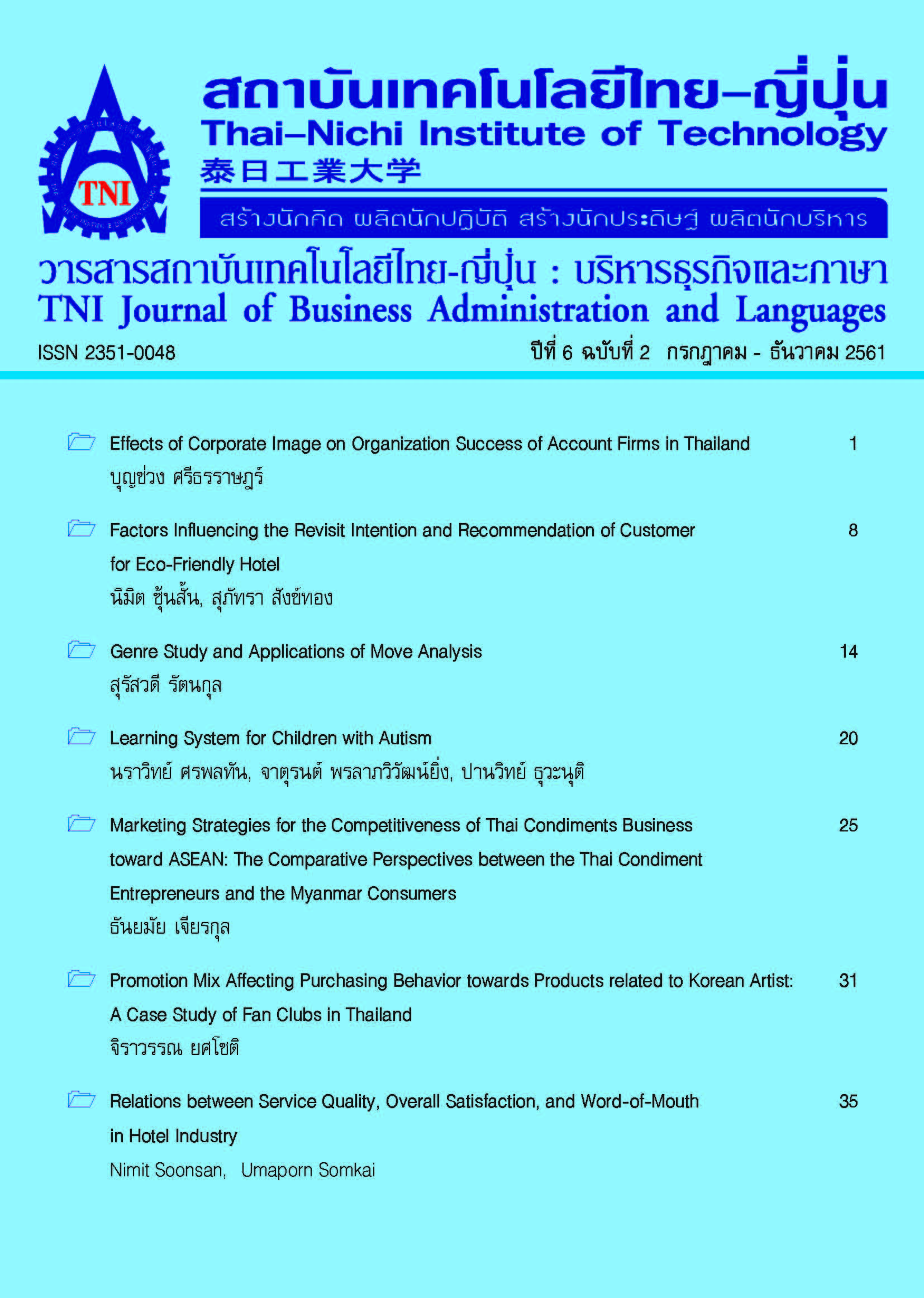The Effect of Dynamic Competitive Advantage and Business Partnership Strategy on SMEs Success in Chainat Province: The Case of Accommodation and Restaurants Business
Main Article Content
Abstract
This research aims to investigate the influence of the Dynamic Competitive Advantage and Business Partnership Strategy that influence SMEs Success in the food processing industry in Thailand. Research model is quantitative research and collecting data from surveys of entrepreneurs in accommodation and restaurant business from 148 companies. The data were analyzed by structural equation model (SEM), the study founded that the Dynamic Competitive Advantage has a direct effect positively to the SMEs Success. Therefore, which business firms need to improve their business success opportunity, they should give precedence to improve their dynamic competitive advantage of their firm. In additional business partnership strategy has a direct effect positively to the SMEs Success.
Article Details
Article Accepting Policy
The editorial board of Thai-Nichi Institute of Technology is pleased to receive articles from lecturers and experts in the fields of business administration, languages, engineering and technology written in Thai or English. The academic work submitted for publication must not be published in any other publication before and must not be under consideration of other journal submissions. Therefore, those interested in participating in the dissemination of work and knowledge can submit their article to the editorial board for further submission to the screening committee to consider publishing in the journal. The articles that can be published include solely research articles. Interested persons can prepare their articles by reviewing recommendations for article authors.
Copyright infringement is solely the responsibility of the author(s) of the article. Articles that have been published must be screened and reviewed for quality from qualified experts approved by the editorial board.
The text that appears within each article published in this research journal is a personal opinion of each author, nothing related to Thai-Nichi Institute of Technology, and other faculty members in the institution in any way. Responsibilities and accuracy for the content of each article are owned by each author. If there is any mistake, each author will be responsible for his/her own article(s).
The editorial board reserves the right not to bring any content, views or comments of articles in the Journal of Thai-Nichi Institute of Technology to publish before receiving permission from the authorized author(s) in writing. The published work is the copyright of the Journal of Thai-Nichi Institute of Technology.
References
Etzioni, Modern organizations. Englewood Cliffs, N.J.: Prentice-Hall, 1964.
F. Angeli and A. K. Jaiswal, “Competitive Dynamics between MNCs and Domestic Companies at the Base of the Pyramid: An Institutional Perspective,” Long Range Planning, vol. 48, no. 3, pp. 182–199, Jun. 2015.
J. F. Hair, Multivariate data analysis: a global perspective., 7th ed. Upper Saddle River, N.J.; London: Pearson Education, 2010.
J. F. Hair, Ed., Multivariate data analysis, 6th ed. Upper Saddle River, N.J: Pearson/Prentice-Hall, 2006.
P. A. Neely, C. Adams, and D. M. Kennerley, The Performance Prism: The Scorecard for Measuring and Managing Business Success: The Scorecard for Measuring and Managing Stakeholder Relationships. London: Financial Times/ Prentice Hall, 2002.
M. E. Porter, Competitive Advantage: Creating and Sustaining Superior Performance. New York: Free Press, 1985.
“SMEs หัวใจที่แท้จริงของเศรษฐกิจไทย,” TA SME. [ออนไลน์]. แหล่งที่มา: https://www.tasme.or.th/article/822/. [เข้าถึงเมื่อ: 15-ส.ค.-2559].
กรธวัฒน์ สกลคฤหเดช, สุกิจ ขอเชื้อกลาง, และ ลภัสรดา จ่างแก้ว, “ความสามารถเชิงพลวัต ความได้เปรียบทางการแข่งขันและความสำเร็จของธุรกิจอุตสาหกรรมอาหารแปรรูปของประเทศไทย,” วารสารเกษมบัณฑิต, ปีที่. 17, ฉบับที่. 2, หน้า. 223–236, ธ.ค. 2016.
ดุษฎี สีมาขจร, กลยุทธ์สู่ความสำเร็จของธุรกิจแฟรนไชส์กาแฟสดไทย. กรุงเทพฯ: มหาวิทยาลัยเทคโนโลยีพระจอมเกล้าธนบุรี, 2552.
ทองใบ สุดชารี, ทฤษฎีองค์การ: วิเคราะห์แนวความคิด ทฤษฎี และการประยุกต์, พิมพ์ครั้งที่ 8. อุบลราชธานี: ภาควิชาบริหารธุรกิจ คณะวิทยาการจัดการ สถาบันราชภัฏอุบลราชธานี, 2551.
ธงชัย สันติวงษ์, พฤติกรรมผู้บริโภคทางการตลาด, พิมพ์ครั้งที่ 11, กรุงเทพฯ: ประชุมช่าง, 2549
บุญเกียรติ ชีวะตระกูลกิจ, การจัดการเชิงยุทธศาสตร์สำหรับ CEO = Strategic management, พิมพ์ครั้งที่ 8. กรุงเทพฯ: สุขุมและบุตร, 2550.
“นิยาม SMEs,” SME Development Bank. [ออนไลน์].แหล่งที่มา: https:// www.smebank.co.th/about/definition. [เข้าถึงเมื่อ: 15-ส.ค.-2559].
“ข้อมูลสถิติ SME - SME2015,” สำนักงานส่งเสริมวิสาหกิจขนาดกลางและขนาดย่อม(สสว.). [ออนไลน์]. แหล่งที่มา: https://203.154.140.77/ sme/Report. [เข้าถึงเมื่อ: 15-ส.ค.-2559].

